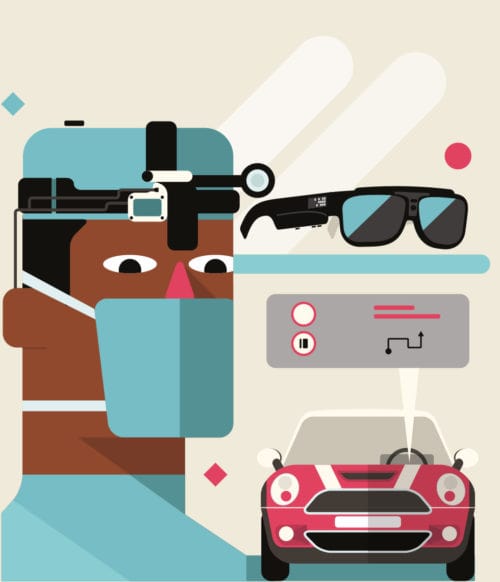Augmented Reality Takes Hold of Medicine, Movies and Flying Machines
Share

This article is an excerpt from “One Good Idea Deserves Another,” originally published in the Innovation Issue of APEX Experience magazine.
APEX Insight: What do rainforest creatures, Uber, smart glasses and the aerospace industry have in common? A few really good ideas. This multipart feature looks at the power of industrious thinking, and how invention migrates from one industry to the next.
Scorpion, an eyepiece slightly smaller than a saltine cracker, gives fighter pilots situational awareness, rapid target acquisition and precise head steering by allowing them to keep their eyes on the target and off the aircraft instrument display panel during critical moments in combat. Developed by Thales, Scorpion is a full-color helmet-mounted cueing system that employs technology that could spread from military use to the hospital operating room.
Harnessing this head-mounted display technology, Thales created DragonFly in partnership with xPlor, its American innovation branch at MIT Media Lab. DragonFly is a surgical headpiece that has already enabled a doctor at NeuroTexas Institute to navigate a spine operation. Using augmented reality, the technology puts graphically enhanced procedures in the surgeon’s direct view and increases operational awareness; it’s also equipped with “telepresence,” a way to consult other medical experts who are logged in.
Car manufacturer BMW has also explored head-up displays with its pair of stylish aviators that merge real and virtual worlds in its MINI Cooper. The automotive company envisions a driving experience where mileage, directions, and rear and side views automatically appear in the lenses of the glasses or are projected onto a windshield. It’s an idea that can also be applied to the act of looking out the passenger window. Panasonic Avionics demonstrated a virtual aircraft window at APEX EXPO 2015.
“You’ll look outside [a window], but it’s augmented with elements of reality and synthetic reality that allow you to understand what you’re flying over.” €” Alexis Steinman, GEE
Global Eagle Entertainment (GEE) is also exploring augmented aircraft views. “You’ll look outside [a window], but it’s augmented with elements of reality and synthetic reality that allow you to understand what you’re flying over; little pieces of history, quiz, whatever,” says Alexis Steinman, SVP, Digital Media Solutions at GEE.
Aviation and medical uses aside, augmented reality boasts real entertainment value, too. Osterhout Design Group’s R-7 Smart Glasses, which also have military origins, could allow passengers to watch movies, write e-mails and surf the Internet. The glasses have been tested with movies from Paramount Pictures and are able to support 3-D films. “This will be a compelling element in the future of in-flight entertainment,” says Joan Filippini, Paramount’s SVP, Non-Theatrical Distribution.
“This will be a compelling element in the future of in-flight entertainment.” €” Joan Filippini, Paramount
Out of the Black Box
Another piece of aviation equipment that could become a fixture in hospitals is the black box, which is vital to airplane crash investigations for its ability to capture cockpit conversations and flight data. Dr. Teodor Grantcharov at St. Michael’s Hospital in Toronto sees their potential in improving patient safety. Grantcharov has tested a prototype during laparoscopic surgeries and likens the recording of operations to sports coaches who use playbacks as a training tool for athletes. “For surgeons, we will have data that will allow better coaching and improvements and therefore better patient care,” he says.


